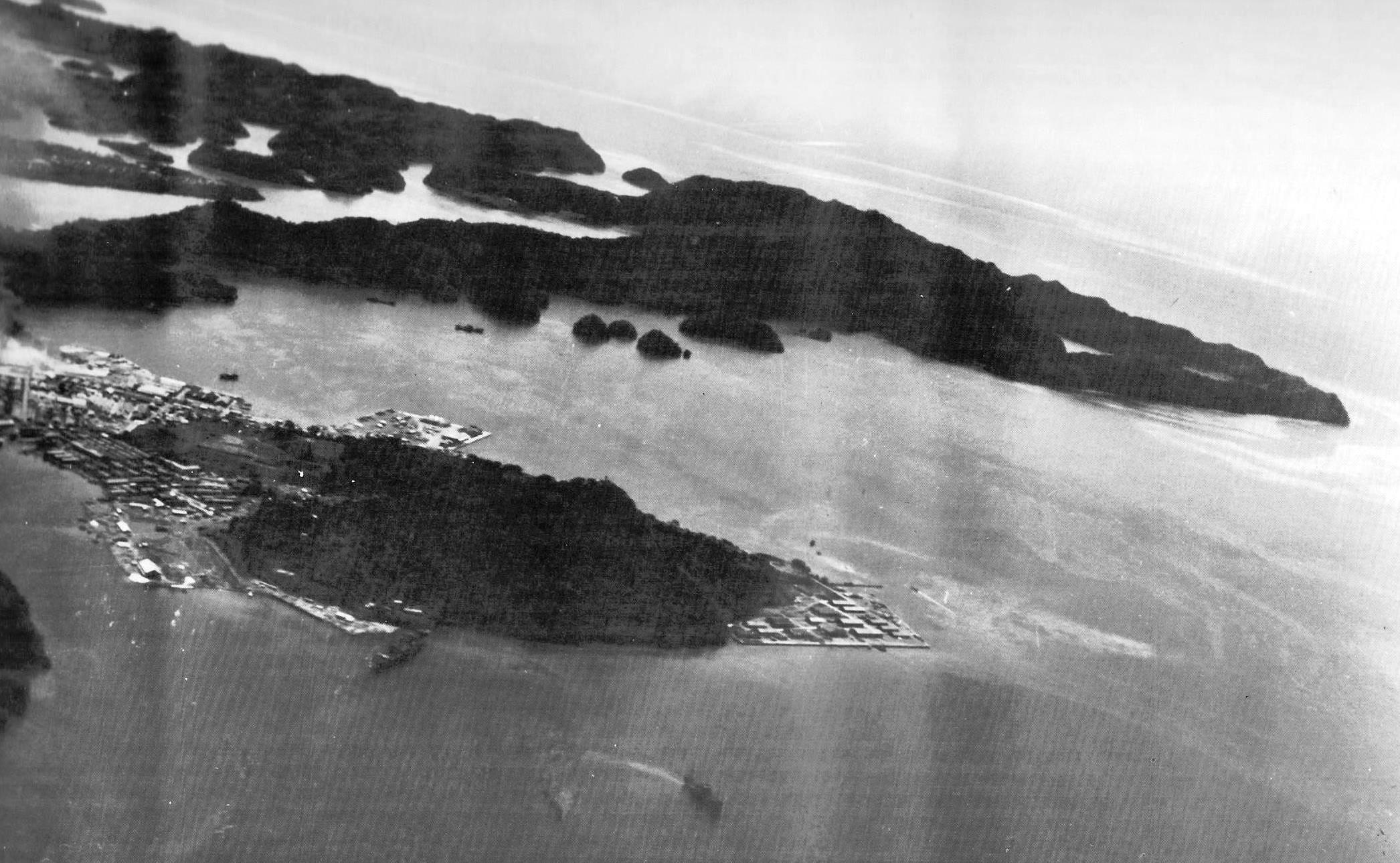Tokusetsu-Kosakubu

(Malakal Island and Palau harbor under USN air attack on 30 March 1944)
History of the IJN's No. 30 Naval Construction and Repair Department at Palau
by Bob Hackett
© 2016 Bob Hackett
In 1712, Spanish missionaries discovered the Palau Islands archipelago that stretches over a hundred miles and includes the largest island of Babelthuap, Koror, Arakabesan Island, Urukthapel, Eil Malk, Ngemelis Island,
Ngeregong Island, Garakayo Island, Malakal, Ngesebus-Kongauru Island, Peleliu and Angaur. In 1899, after its defeat in the Spanish-American War, Spain sold the islands to Germany. The Germans exploited the islands’
extensive phosphates reserves, but on 14 August 1914 the Japanese declared war on Germany and seized their Pacific possessions, including the Palaus. In 1920, the League of Nations awarded the mandates to Japan.
Between the wars, Japan established a major presence on the Palau Islands. With the withdrawal of Japan from the League of Nations in 1935, the Palaus were closed to Westerners. Military facilities were expanded
to include airfields, two seaplane bases and some coastal defenses.
The main facilities on Babelthuap Island island were owned by the South seas Aluminum Mining Co. that produced about 10 percent of Japan’s aluminum supply. The island had the only pier suitable for deep draft vessels.
In the Pacific War, the importance of the Palaus grew as it became a forward supply, training and staging point for the Japanese. Malakal Island was the site of the IJN’s main repair yard on the NW side of the island.
It consisted of a small (425’ x 85’) dry dock, several wharves one of which was suitable for medium draft vessels, a fuel oil depot, shops, slips,warehouses and other facilies.
IJN naval vessels primarily anchored in the main naval anchorage at Kobasang Harbor located between Arakabesan and Malakal Islands while Koror Island’s north harbor was used exclusively by merchant ships
and had been used by passenger ships prewar. Kombail Lagoon located W of Koror Harbor was used by IJN submarines, sub tenders and oilers.
About 27 August 1943, auxiliary transport IJN AMAGISAN MARU arrived at Palau and probably underwent emergency repairs.
On 24 February 1944, IJN Repair Ship AKASHI, damaged by bombs at Truk, arrived at Palau. AKASHI performed self-repairs supervised by AKASHI's Kosakubucho Captain/Eng Kubo Tokuichi.
On 10 March 1944, the IJN No. 30 Naval Construction and Repair Department was established at Malakal Island, Palau under Captain/Eng Kawai Fukashi (28).
About 10 March 1944, transport BICHU MARU, torpedoed on 29 Dec '43 near Palau, arrived alongside AKASHI for more permanent repairs supervised by AKASHI's Captain/Eng Kubo which were completed on
28 March 1944.
On 14 March 1944, divers from AKASHI inspected damage to PB-102 (ex-USS STEWART, DD-224), hit by a dud torpedo on 9 Mar '44. The damage was minor and PB-102 departed the next day escorting a convoy.
On 27 April 1944, kaibokan KASADO was hit by a torpedo by USS TRIGGER (SS-237) that blew off her bow. KASADO reversed course back to Palau and arrived there the next day. Emergency repairs were
performed and a temporary false bow fitted.
On 30-31 March 1944, in American Operation “Desecrate One”, the Palau anchorage was attacked by F6F "Hellcats", SBD "Dauntless", TBF "Avenger" and SB2C "Helldiver" carrier aircraft of Task Group 58. 1's
USS ENTERPRISE (CV-6), BELLEAU WOOD (CVL-24) and COWPENS (CVL-25), TG 58. 2's BUNKER HILL (CV-17), HORNET (CV-12), MONTEREY (CV-26) and CABOT (CVL-28) and TG 58. 3's YORKTOWN
(CV-10), LEXINGTON (CV-16), PRINCETON (CVL-23) and LANGLEY (CVL-27). Thirty-six ships are sunk in the raid.
TF 58's planes find AKASHI anchored in shallow water in a cove off the northern part of Urukthapel Island. She sustains numerous direct hits and near misses by bombs and rockets. AKASHI suffers at least seven hits on her stern, two on her port bow,
one on her superstructure forward of the well deck, two amidships and another aft of her stack that causes a fierce fire. AKASHI sinks by the bow in the shallow water. Her bridge, crane tops and masts remain above water. An unknown number of
crewmen survive.
On 8 August 1944, Captain/Eng Kawai is KIA. He was promoted Rear Admiral/Eng, posthumously.
On 13 August 1944, Captain/Eng Goto Shukichi (26) is appointed Director of the IJN No. 30 Naval Construction and Repair Department. He was promoted Rear Admiral/Eng on 1 May 1945 and served as Director
until 15 August 1945.
On 27 November 1944, after 73 days of horrific fighting by the U. S. First Marine Division, Peleliu was declared secure. The battle for Peleliu cost the Marines 1,262 KIA and 5,274 WIA in one of the worst
slaughters of US Marines in the Pacific theater. The Japanese lost 10,000 KIA.
After Japan surrenders in September 1945, the Americans finally occupy the rest of Palau.
Author's Notes:
Thanks go to Fontessa-san of Japan, on "Axis History Forum" for the incredible amount of work he went to combing through the (Kaigun Jirei Koho)
Naval Transfer and Promotion Lists and JACAR to find the Directors of the IJN's Naval Construction and Repair Departments. Thanks also to Sander Kingsepp of Estonia.
Questions to the author should be posted on the Discussion
& Questions board.
-Bob Hackett
Back to Japan's IJN Overseas Naval Construction and Repair Departments





